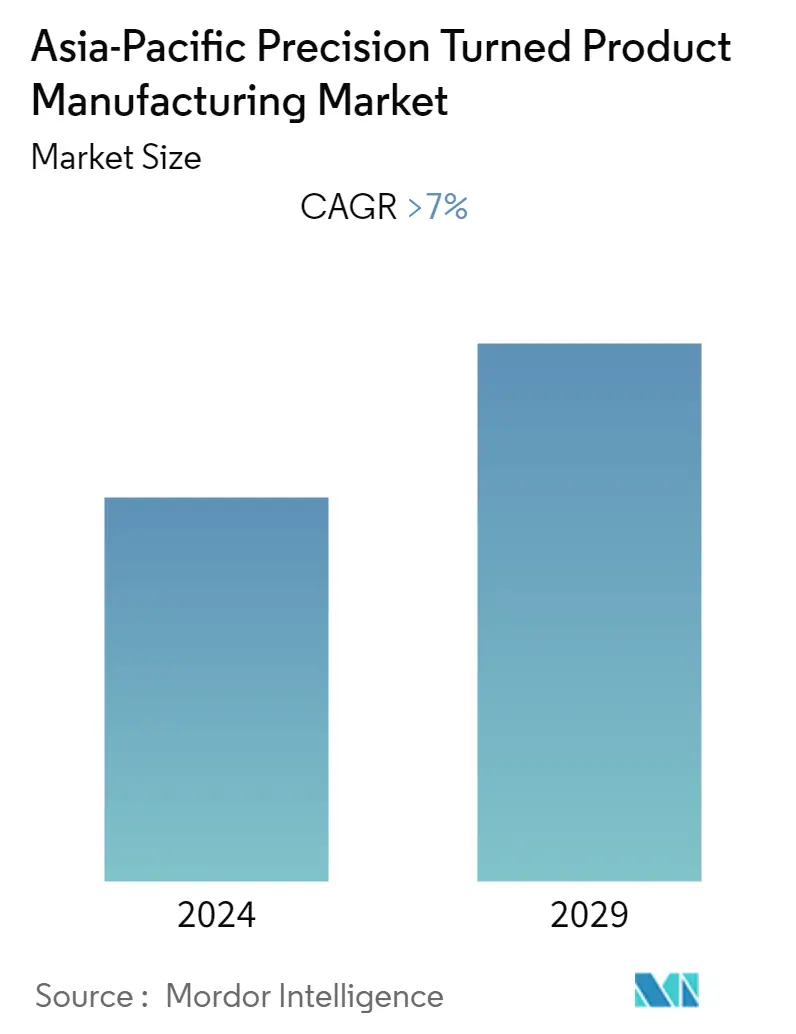Market Size of Asia-Pacific Precision Turned Product Manufacturing Industry

| Study Period | 2020 - 2029 |
| Base Year For Estimation | 2023 |
| Forecast Data Period | 2024 - 2029 |
| Historical Data Period | 2020 - 2022 |
| CAGR | > 7.00 % |
| Market Concentration | Low |
Major Players
*Disclaimer: Major Players sorted in no particular order |
Need a report that reflects how COVID-19 has impacted this market and its growth?
APAC Precision Turned Product Manufacturing Market Analysis
The size of Asia-Pacific precision turned product manufacturing market is around USD 6 billion and is anticipated to register a CAGR of more than 7% over the forecast period. The huge potential in the manufacturing sector of Asian countries mainly drives the market. China and India are providing manufacturing services at a very low cost, and the industry is transforming with advanced technology. While Singapore, a precision engineering hub, expects a huge demand from other parts of the world to drive the market.
- Following the trade war between the United States and China, the supply chain revolution has become a major source of concern. This revolution will result in the transfer of enterprise production bases and even the entire supply system, forming several regional-based manufacturing centers. The ASEAN region has benefited from regional manufacturing. Nevertheless, unlike in the past, the ASEAN region is not based on labor outsourcing but has gradually developed into a smart manufacturing center, with Singapore leading the way.
- The Southeast Asian Manufacturing Alliance was established in 2020 by Singapore and officially launched in March 2021. Through the spirit of the alliance, it integrates manufacturers from ASEAN countries, connecting Malaysia, Vietnam, and Indonesia. Aiming at foreign large-scale and local manufacturers, it will form a close regional cooperation alliance to help manufacturers build a digital supply chain in more than 10 industrial zones and increase their market share. The benefit of SMEs implementing smart manufacturing is that it allows them to manage their daily operations more efficiently and differentiate themselves from competitors through innovative mechanisms. Obtaining real-time data from the manufacturing process for business decision-making and prediction/problem-solving is a critical component of smart manufacturing.
- China's machinery industry, which is already a global leader, is entering a new era of sophistication. According to the China Machinery Industry Federation, sales revenue for the section reached CNY 12.95 trillion (USD 1.87 trillion) in the first half, up 5.44% year on year. Strategic emerging subcategories accounted for 79.3% of total revenue and 76.64% of total profits in the machinery industry, growing 3.38% and 2.67%, respectively. In addition, the machinery company debuted its Bright-eye teaching-free robot welding technique at the 2022 WRC. It solves problems such as low automation rates, low welding rates, and poor production through ultrahigh-precision 3D vision and laser perception systems, as well as Sany's unique expert welding process database and offline programming technology.
- Precision engineering is paving the way for India to become self-sufficient. The current geopolitical challenges have highlighted the critical importance of "Atmanirbharta" in strengthening the country's digital infrastructure. The current geopolitical challenges have highlighted the critical importance of "Atmanirbharta" in strengthening the country's digital infrastructure. In FY22, India had a current account deficit (CAD) of 1.2%and India's widening current account deficit is exacerbated by a surge in crude and other imports, which has led to an in domestic inflation. As a result, striving for rapid self-sufficiency and strengthening domestic industries in core and critical segments is critical to catapult the country into a precision manufacturing and technological orbit.
